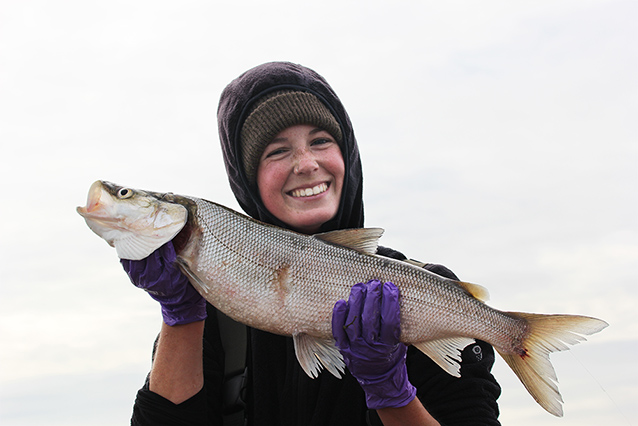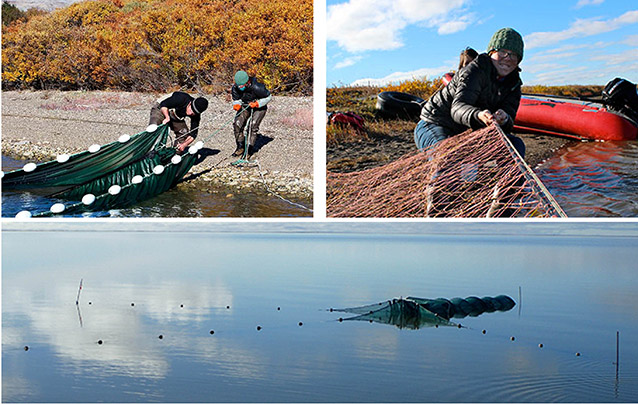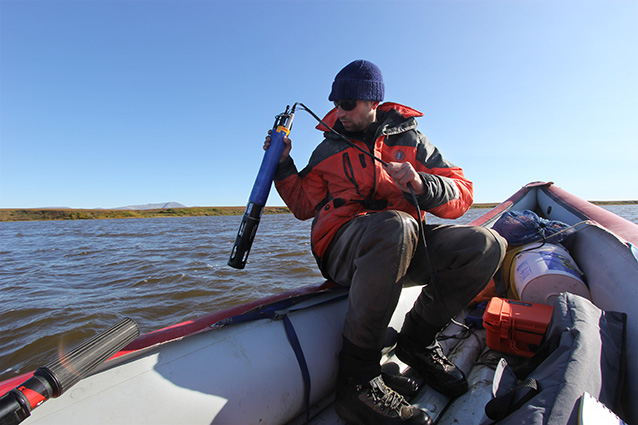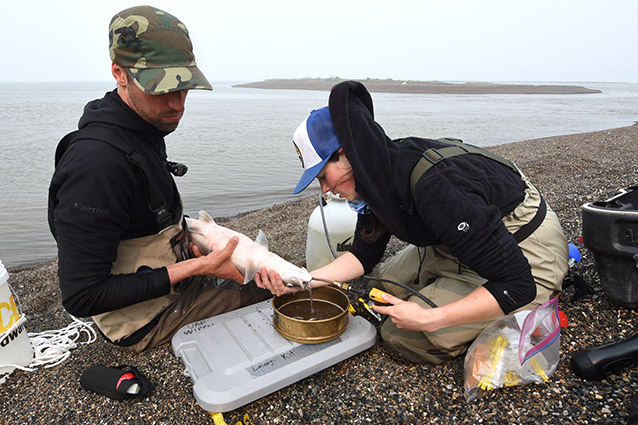
NPS Photo
Within the western Arctic parks, there are seven coastal lagoons described within the boundary of Cape Krusenstern National Monument—Aukulak, Imik, Ipiavik, Kotlik, Krusenstern, Port, and Sisualik; and four coastal lagoons within the boundary of Bering Land Bridge National Preserve—Lopp, Kupik, Shishmaref, and Ikpek. Sediment transport is beginning to form a fifth lagoon in the shallow, protected waters behind Cape Espenberg. These shallow, dynamic coastal lagoons represent a critically important ecosystem in the region, supporting avian, fish, and invertebrate populations, in addition to being used by both terrestrial and marine mammals.

The western Arctic lagoons are found at the nexus of both the North American and Asian avian flyways, with habitat that supports migratory seabird, shorebird, and waterfowl populations resident to northern and southern hemisphere Asian and American continental avian populations. They support seasonal subsistence activities and are used as navigational pathways throughout the year by local village residents. These subsistence practices have continued for thousands of years, attested to by rich cultural and archaeological sites found in immediate proximity to the lagoons.
The lagoons are extremely vulnerable to both climate change and human impacts from increased activities in and around the region. The lagoons in Cape Krusenstern can seasonally open and close to the ocean with seasonal storm events, and Bering Land Bridge lagoons have seen significant changes in the erosion and deposition of sediments along the exterior barrier islands and particularly within the lagoon inlets.
Challenged by remote access, and encumbered with extremely difficult logistics, studies of this area have been few. While there have been multiple attempts since the 1970s to study these coastal areas with some success, the study purpose, and temporal and spatial separations of these studies has made developing a cohesive reference condition understanding of the biological and physical characteristics of these lagoons nearly impossible.
Initial work in the area prior to the establishment of the western Arctic parks focused on avian fauna with limited lower trophic information collected on planktonic communities (Conners and Conners 1982; Connors and Risebrough 1977, 1978). Raymond et al. (1984) collected some limited basic physical water quality, fish, and invertebrate composition in lower Cape Krusenstern lagoons. The Red Dog Mine environmental studies (Dames and Moore 1983; Blaylock and Erikson 1983; and Blaylock and Houghton 1983) were fairly thorough during their two years, and collected avian fauna information along with physical water quality parameters, fish, and invertebrate data. However, the Red Dog environmental studies program focused only on lagoons in northern Cape Krusenstern as part of the environmental studies necessary to site the Red Dog port facilities for the development of the Red Dog Mine, haul road, and port. They did provide some insight into the ecological functioning of the lagoons, indicating that while the lagoons were open, they provided a greater degree of species diversity than when they were closed to the ocean.
Limited scientific studies outside of avifauna were completed in the lagoons following the Red Dog environmental studies, until the NPS Arctic Inventory and Monitoring Network was established. The Arctic Network focuses ecosystem monitoring in five northern Alaska parks, including the coastal lagoons of Cape Krusenstern and Bering Land Bridge (Lawler et al. 2009). In 2007, the Arctic Network began developing a protocol for western Arctic coastal lagoons to support informed management decisions as outlined in the parks’ General Management Plans (NPS 1986a and 1986b).
Lagoon Protocol Development
Lagoon monitoring efforts are intended to address the need for reference conditions followed by standardized monitoring of the structure and function of lagoons, as well as local fish resources used for subsistence (Lenz et al. 2001). Without a clear understanding of reference conditions in the lagoons, including the seasonality and inter-annual variability of physical and biotic components, it’s impossible to detect long-term changes, quantify accident/incident impacts, or even develop appropriate management plans designed to protect key functions of these lagoons for local ecosystem services and subsistence economies.

Reynolds et al. (2005) conducted physicochemical (including nutrients) and biological (zooplankton, epibenthos, and fish) sampling in five of the seven Cape Krusenstern coastal lagoons (Imik, Kotlik, Krusenstern, Aqulaaq, and Sisualik); they were the basis for her PhD dissertation (Reynolds 2012).
Supported by the Arctic Network during 2009, Reynolds sought to effectively survey and develop a monitoring protocol for coastal lagoons in Cape Krusenstern to document the long-term status and trends of physical, chemical, and biological components. Reynolds’ efforts provided reference condition data of water quality and some zooplankton information for the lagoons, but additional work was still needed to better understand temporal and spatial variability. Because of the variability seen in the data, there was not enough data collected for reliable conclusions about seasonal or interannual variability, particularly for lagoons only sampled once. In 2012, Robards (2014) conducted biological and physical study of lagoons in Cape Krusenstern and Bering Land Bridge to assist NPS with the design and implementation of the Coastal Lagoon Vital Signs program. This research broadened our understanding of the physical dynamics of lagoons and the spatial distribution of the fish communities across lagoons.
Methods and Results
Through a collaborative effort between the Wildlife Conservation Society, the Native Village of Kotzebue, and NPS, we expanded on the research of Robards (2014) to aid in Vital Signs protocol development for coastal lagoons. During the ice-free season of 2015, we sampled fish communities and water quality of three lagoons (Aukulak, Krusenstern, and Kotlik) in Cape Krusenstern and two lagoons (Kupik and Ikpek) in Bering Land Bridge. Our objectives for fisheries data collection in 2015 were to:
Document fish community composition and patterns of use in the coastal lagoons. Lagoons in these parks range in size, connectivity, and saltwater influence, allowing us to sample fish distributions, abundance, and community composition through the season and across selected environmental gradients.
Examine trophic structure of lagoons by sampling fish diets. Examining fish diets establishes key trophic linkages among species and begin to develop a broader understanding of Arctic lagoon food webs.
Measure fish growth rates for resident and migratory species. Documenting fish growth rates will be used to monitor long-term changes in fish condition, and ultimately changes to the lagoon conditions that affect fish growth.
Using several fishing methods (Table 1, Figure 2), we sampled lagoons for fish community composition, seasonal and spatial patterns of use, trophic dynamics, and health. Building on previous work, we documented 26 fish species total, five of which have not been recorded in any of these lagoons before and 33 instances where species were new to specific lagoons (Table 2). We monitored water quality through the season (three to five times total per lagoon) at the three lagoons in Cape Krusenstern, and once for the two lagoons in Bering Land Bridge (Table 3, Figure 3). We also attempted to sample water quality in the protected waters behind Cape Espenberg; however, extremely shallow water throughout (less than 0.98 feet [30 centimeters]) prevented us from collecting data.
Below: Table 1
Fishing effort over the season using three methods. Fishing hours for beach seine is not displayed as this is an active-sampling method (each seine replicate takes approximately 15 minutes to set).
| Method | July | August | September | Total |
|---|---|---|---|---|
| Beach seine | 9 | 11 | 18 | 38 |
| Fyke net | 4 (18:32) | 1 (3:35) | 2 (4:50) | 7 (26:57) |
| Gill net | 26 (48:03) | 19 (26:58) | 22 (43:45) | 67 (118:46) |

For the lagoons that we were able to sample, water quality appeared to be affected by lagoon connectivity to the marine environment and the amount of freshwater input. Fish community composition correlated with the physical dynamics and characteristics of the lagoons. Variation in lagoon connectivity to the Chukchi Sea also affected the timing and duration for which lagoons were accessible to marine species. Catches of migratory species (e.g., sheefish [Stenodus nelma], humpback whitefish [Coregonus pidschian]) generally decreased towards the end of the season as fish left the lagoons, likely in response to the potential loss of connectivity to overwintering habitat as freeze-up approached. Traditional knowledge and past research suggest that fish likely move back into river systems to overwinter. Our preliminary observations of fish diets suggest that mysids (Mysid spp.) and ninespine stickleback (Pungitius pungitius) are critical for transferring energy from secondary producers to top predators. Mysid densities in the lagoons were remarkable, and this was reflected in the diets of fish. Mysids were present in the stomachs of almost every species we sampled for diet, and many species fed on mysids almost exclusively. However, ninespine stickleback, which were also highly abundant in the lagoons, were fed on heavily by pisciviorous fish (e.g., sheefish; Figure 4) and birds (e.g., Arctic terns [Sterna paradisaea]).
New Species
New species caught in each lagoon in the 2015 field season:
| Species | Aukulak | Krusenstern | Kotlik | Kupik | Ikpek |
|---|---|---|---|---|---|
| Arctic flounder | yes | no | yes | yes | yes |
| Pacific herring | yes | no | no | no | yes |
| Longhead dab | yes | no | no | no | no |
| Rainbow smelt | yes | no | yes | yes | no |
| Saffron cod | yes | yes | no | no | yes |
| Starry flounder | yes | no | no | yes | no |
| Dolly varden | no | yes | no | no | no |
| Pond smelt | no | yes | no | yes | yes |
| Fourhorn sculpin | no | yes | no | yes | yes |
| Pink salmon | no | yes | yes | no | no |
| Least cisco | no | no | yes | no | no |
| Pacific sand lance | no | no | yes | no | no |
| Sheefish | no | no | yes | no | no |
| Tubenose poacher | no | no | yes | no | no |
| Ninespine stickleback | no | no | no | no | yes |
| Unidentified sculpin | no | no | yes | no | no |
Note: We are currently confirming the identification of 3 sculpin species we captured in this lagoon.
| Lagoon | Year | Temp (°C) | Dissolve oxygen (mg/L) | pH | Salinity (PSU) | Turbidity (NTU) |
|---|---|---|---|---|---|---|
| Kotlik | 2015 | 15.57 | 9.45 | 8.12 | 22.18 | 3.55 |
| Kotlik | 2012 | 12.39 | 10.93 | 8.84 | 17.61 | 41.89 |
| Krusenstern | 2015 | 13.96 | 11.53 | 8.82 | 1.48 | 8.39 |
| Krusenstern | 2012 | 12.58 | 12.71 | 9.77 | 4.03 | 56.9 |
| Aukulak | 2015 | 17.49 | n/a | 9.1 | 20.04 | 8.32 |
| Aukulak | 2012 | 12.29 | 11.6 | 8.87 | 4.03 | 35.9 |
| Kupik | 2015 | 14.99 | 10.93 | 8.55 | 26.6 | 2.65 |
| Kupik | 2012 | 14.74 | 11.22 | 9.12 | 20.65 | 2.83 |
| Esperiberg | 2015 | 13.82 | n/a | 7.88 | 31.9 | 0.7 |
| Ikpek | 2015 | 15.77 | 11.04 | 8.37 | 27.8 | 1.64 |
| Ikpek | 2012 | 13.67 | 12.79 | 9.2 | 22.53 | 1.37 |
Notes:
- Salinity is measured in Practical Salinity Units, which is a unit based on the properties of seawater conductivity
- Turbidity is measured in Nephelometric Turbidity Units, which is a unit based on the propensity of particles to scatter a light beam
For the lagoons that we were able to sample, water quality appeared to be affected by lagoon connectivity to the marine environment and the amount of freshwater input. Fish community composition correlated with the physical dynamics and characteristics of the lagoons. Variation in lagoon connectivity to the Chukchi Sea also affected the timing and duration for which lagoons were accessible to marine species. Catches of migratory species (e.g., sheefish [Stenodus nelma], humpback whitefish [Coregonus pidschian]) generally decreased towards the end of the season as fish left the lagoons, likely in response to the potential loss of connectivity to overwintering habitat as freeze-up approached. Traditional knowledge and past research suggest that fish likely move back into river systems to overwinter. Our preliminary observations of fish diets suggest that mysids (Mysid spp.) and ninespine stickleback (Pungitius pungitius) are critical for transferring energy from secondary producers to top predators. Mysid densities in the lagoons were remarkable, and this was reflected in the diets of fish. Mysids were present in the stomachs of almost every species we sampled for diet, and many species fed on mysids almost exclusively. However, ninespine stickleback, which were also highly abundant in the lagoons, were fed on heavily by pisciviorous fish (e.g., sheefish; Figure 4) and birds (e.g., Arctic terns [Sterna paradisaea]).
We collected fish length data and otolith data to examine fish growth rates for resident and migratory species. We gathered length-weight measurements and otoliths from pond smelt (Hypomesus olidus), a poorly studied species, which was identified in lagoons for the first time this season. Smelt were locally abundant and consequently may play an important role in the trophic dynamics in certain lagoons. To examine fish health, we are partnering with the State of Alaska to analyze contaminants in nine species, collected from several lagoons (Table 4). Data we collected in 2015 builds on prior traditional knowledge and research, provides ecological information vital for monitoring and managing Arctic lagoons of these parks, and will continue to inform a comprehensive understanding of the Story of the Lagoons—a key publication priority for the Native Village of Kotzebue, the Wildlife Conservation Society, and the National Park Service.
Table 4: Number of contaminant samples collected per species for each lagoon in Cape Krusenstern National Monument
| Species | Krusenstern | Aukulak | Kotlik |
|---|---|---|---|
| Bering cisco | 5 | 0 | 0 |
| Fourhorn sculpin | 2 | 0 | 5 |
| Humpback whitefish | 6 | 4 | 0 |
| Least cisco | 3 | 2 | 0 |
| Ninespine stickleback | 5 | 0 | 0 |
| Pacific herring | 5 | 0 | 0 |
| Saffron cod | 0 | 5 | 5 |
| Sheefish | 3 | 0 | 0 |
| Starry flounder | 5 | 4 | 5 |
Conclusions
From a climate change perspective, increased coastal erosion has the potential to profoundly alter the physical, chemical, and biological dynamics of the lagoons. New dynamics of lagoon breaching will affect salinity, prey resources, and alter fish community patterns and the availability of important subsistence fish species. Coastal lagoons are also facing potential threats from increased development in the Arctic including potential oil and gas development in the northern Chukchi Sea, deep-water ports in the northern Bering Sea, and increased international shipping along the Northern Sea Route above Siberia. This project will foster a better understanding of the long-term threats to fisheries resources of coastal lagoons in the western Arctic and helps disentangle the role of climate change influences from other potential impacts. Our research activities will also illuminate how to prioritize protections across the wide number of lagoons along the northwest Alaska coast. Specifically, we are using these field efforts to: (a) provide a summary of reference conditions in the lagoons of western Arctic parks; (b) continue development of the Arctic Network monitoring program, (c) frame more in-depth assessments to place long-term monitoring in the context of seasonal variability, (d) complement new subsistence fisheries research we are conducting in collaboration with the Native Village of Kotzebue to better understand the management needs for whitefish in these coastal lagoons, and (e) begin to assess prioritization of coastal lagoons for protection from oil spills based on their ecological or subsistence contribution.
This season’s work provides a valuable advance in our understanding of the aquatic ecology of Arctic coastal lagoons, which will be key in managing these habitats into the future. However, the high number of instances where we discovered species new to specific lagoons demonstrates that we are still capturing baseline fisheries information for these dynamic systems, and more research is necessary. Our plans to collect further fish data will be paired with parallel efforts we are undertaking to understand subsistence fishing harvest and lagoon physical dynamics, such as coastline change, water quality, ice formation, and water balance. We expect our sampling in the summers of 2016-2017, as well as our planned winter sampling, will not only establish the strong baselines necessary for monitoring programs to detect change, but also uncover important aspects of the aquatic ecology necessary for management of the Arctic lagoons .
Acknowledgments
We would like to acknowledge the National Parks Foundation for the funding supporting this research through the Coastal Settlement Fund and the Western Arctic National Parklands and NPS Alaska Regional Office for extensive logistical support. Without the following people, who made substantial contributions to the fieldwork and logistics of this project, this work would not have been possible: Nicole Farnham, Ryan Sherman, Stacia Backensto, Marci Johnson, Dan Shelden, Bob Schaeffer, Dave Rosser, Carrie Haddad, Melanie Flamme, Cyrus Harris, Colin McKenzie, Ben Meyer, Kristin Rine, and Kristen Sellmer. This project was also supported by a host of staff from the Wildlife Conservation Society and the University of Alaska-Fairbanks, to whom we are very grateful.
References
Blaylock, W. and J. Houghton. 1983.
1983 Lagoon Investigations. Supplement to Environmental Baseline Studies, Red Dog Project.
See Dames and Moore.
Blaylock, W. and E. Erikson. 1983.
Marine Biology. Chapter 4 in Environmental Baseline Studies. See Dames and Moore.
Connors, P. and C. Connors. 1982.
Shorebird littoral zone ecology of the southern Chukchi coast of Alaska. Final Report. Outer Continental Shelf Environmental Assessment Program. Research Unit 172.
Connors, P. and R. Risebrough. 1977.
Shorebird dependence on arctic littoral habitats. Environmental Assessment of the Alaskan Continental Shelf (Annual Reports of Principal Investigators). Volume 3: 402-524.
Connors, P. and R. Risebrough. 1978.
Shorebird dependence on arctic littoral habitats. Environmental Assessment of the Alaskan Continental Shelf (Annual Reports of Principal Investigators). Volume 2: 84-166.
Dames and Moore. 1983.
Environmental baseline studies, Red Dog Project. Prepared for Cominco Alaska, Inc. Available at University of Alaska, Fairbanks – Rasmussen Library.
Lawler, J., S. Miller, D. Sanzone, J. Ver Hoef, and S. Young. 2009.
Arctic Network vital signs monitoring plan. Natural Resource Report NPS/ARCN/NRR—2009/088. Fort Collins: National Park Service.
Lenz, J., T. Gotthardt, R. Lipkin, and M. Kelly. 2001.
Compilation of Existing Species Data in Alaska’s National Parks, Final Report. Alaska Natural Heritage Program, Environment and Natural Resources Institute. Anchorage: University of Alaska
National Park Service (NPS) 1986a.
Cape Krusenstern National Monument General Management Plan. U.S. Department of the Interior. 220p.
National Park Service (NPS) 1986b.
Bering Land Bridge National Preserve, Alaska. General Management Plan, Land Protection Plan, Wilderness Suitability Review. U.S. Department of the Interior.
Raymond, J., M. Merritt, and C. Skaugstad. 1984.
Nearshore fishes of Kotzebue Sound in summer. Alaska Department of Fish and Game, Division of Fisheries Rehabilitation, Enhancement and Development (FRED) Report. Number 37.
Reynolds, M. 2012.
Arctic Coastal Lagoons of Cape Krusenstern National Monument: Subsistence, Ecosystem Characterization, and Management. PhD Dissertation. East Carolina University. 290pp.
Reynolds, M., T. Reynolds, C. Lean, and L. Clough. 2005.
Cape Krusenstern National Monument: Year-round sampling to characterize water quality, species richness, and food web structure in five coastal lagoons. Alaska Park Science 4(1): 38-43.
Robards, M. 2014.
Coastal lagoon community and Ecological monitoring in the Southern Chukchi Sea National Park Unit over five decades – Status and 2012 Field Sampling Report. Report by the Wildlife Conservation Society for the U.S. National Park Service, Cooperative Ecosystem Studies Unit Agreement #: P12AC14948.
Part of a series of articles titled Alaska Park Science - Volume 15 Issue 1: Coastal Research Science in Alaska's National Parks.
Last updated: November 17, 2016
